Home Entertainment Blog Archive
Brought to you by your friendly, opinionated, Home Entertainment and Technology writer, Stephen DawsonHere I report, discuss, whinge or argue on matters related to high fidelity, home entertainment equipment and the discs and signals that feed them. Since this Blog is hand-coded (I like TextPad), there are no comments facilities. But feel free to email me at scdawson [at] hifi-writer.com. I will try to respond, either personally or by posting here emails I consider of interest. I shall assume that emails sent to me here can be freely posted by me unless you state otherwise.
This archive is for an uncertain period commencing Thursday, 12 August 2004
Gregory writes:
I wonder if you could answer a question that arose from your column "All-write recorder", a review of the Philips DVDR77 DVD recorder, from The Canberra Times 16/8/2004.The 4:3 limitation is for recording in the +VR format (this apparently stands for 'Real Time Video') used on consumer DVD+R/RW recorders. When using a computer burner, particularly if copying existing discs, the result is in DVD-Video format, and the 16:9 attribute is carried across without difficulty.You wrote that "... DVD+R and +RW discs, at least when used in a consumer recorder, do not support a 16:9 aspect ratio. All discs recorded will have 4:3 coded as their video aspect."
A friend played back a copy of one of his 16:9 discs (The Battle of Britain) on both his wide screen and 4:3 televisions. He said the disc played back correctly on the 4:3 TV, with black bars at top and bottom of the screen, but the picture was not distorted.
Is this because the discs he used were cut on a PC?
I was wondering if you could provide a URL where this sort of problem is discussed?
The +VR format is discussed in this article at DVDPlusRW.ORG. Look under 'Aspect Ratio'. You may have to read this a couple of times to make sense of it (I did) because it is phrased as though this inability is some kind of a virtue. Which, of course, it isn't.
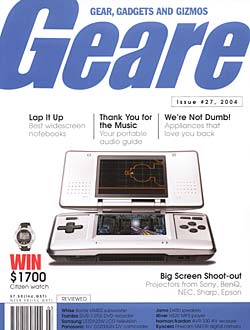 For some years I've been writing for the magazine Geare, usually just reviews of the assorted bits and pieces that I review. I was always a bit ambivalent abou it because Geare is one of those 'guys' magazines, in which everything purported to be of interest to men was gathered within its pages -- cars, home entertainment, cameras, motorbikes ... and girls. There was always a multi-page spread of some attractive young lady, scantily dressed, with just a, er, fig-leaf of relevance in the form of a product list on each page (watch by so-and-so Swiss watch-making firm, G-string by such-and-such).
For some years I've been writing for the magazine Geare, usually just reviews of the assorted bits and pieces that I review. I was always a bit ambivalent abou it because Geare is one of those 'guys' magazines, in which everything purported to be of interest to men was gathered within its pages -- cars, home entertainment, cameras, motorbikes ... and girls. There was always a multi-page spread of some attractive young lady, scantily dressed, with just a, er, fig-leaf of relevance in the form of a product list on each page (watch by so-and-so Swiss watch-making firm, G-string by such-and-such).
Not porn by the conventional measure of level of exposure, but certainly porn by the standard of reason for inclusion.
Happily, several issues ago, the magazine came to the realisation that if a bloke wants porn, there's plenty of it around from specialist publications, and most of this is much more, um, satisfying than one picture spread of a girl in pre-1960s Playboy levels of attire.
Getting rid of the girl has had another effect, even more pleasing to me. Namely, Geare is now commissioning more stuff from me. So the new issue -- #27, 2004, which should be on the newsagency shelves across Australia and New Zealand any day now -- has my 'Know it all' column in its usual garish yellow (all about DLP projectors), and my history of the Internet. Go get it.
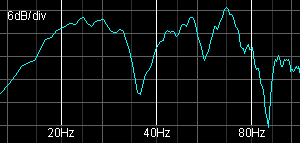 My review of the Whise Profunder 319A subwoofer ($6,499) appeared in Wednesday's 'Connect' section in the Melbourne Herald Sun newspaper, unfortunately under someone else's name. No matter. The graph herewith is something I couldn't put in the article. This shows the in-room frequency response of this sub. Ignore the dip at 36 hertz. That's an artefact of microphone/subwoofer location in my particular room. Just look at how deep it goes. The roll-off at the bottom end is not as steep as I would have expected from the enclosure design, so I reckon it's still delivering some output at 15 hertz.
My review of the Whise Profunder 319A subwoofer ($6,499) appeared in Wednesday's 'Connect' section in the Melbourne Herald Sun newspaper, unfortunately under someone else's name. No matter. The graph herewith is something I couldn't put in the article. This shows the in-room frequency response of this sub. Ignore the dip at 36 hertz. That's an artefact of microphone/subwoofer location in my particular room. Just look at how deep it goes. The roll-off at the bottom end is not as steep as I would have expected from the enclosure design, so I reckon it's still delivering some output at 15 hertz.
 Philips Electronics flew me up to Sydney today to have a look at some of its forthcoming products. It was focusing on its new, expanded, Flat TV lineup, but there were some other interesting products there as well.
Philips Electronics flew me up to Sydney today to have a look at some of its forthcoming products. It was focusing on its new, expanded, Flat TV lineup, but there were some other interesting products there as well.
The Flat TVs consisted of new high resolution 42 and 50 inch plasma models, and several LCD ones. The most interesting of the latter was the 42PF9986, a 42 inch (107cm) model which, as far as I can work out, is the biggest LCD currently on the market. Looked very good where they were showing it, but I won't be able to give a final verdict until I get one here to examine in my more familiar environment. All the Philips consumer flat panel displays are kitted out as TVs (ie. with analogue TV tuners and speakers built in). This large LCD unit uses NXT panel speakers. I don't particularly like the sound from most NXT panels (and I forgot to ask them to play something through this TVs speakers, so I don't know if it sounds any better), but the lack of speaker grilles certainly looked nice. Resolution: 1,366 x 768 pixels. Contrast ratio (the weak point of LCDs): 500:1. Price: $14,949.
Most of these new TVs come with Philips' 'Ambi light', which is a couple of lights on the back to glow against the rear wall. The basic idea is good. Such lights have the effect of improving your eyes' perception of the picture because, in a darkened room, it no longer looks like a bright white square on a black background. Remember that our vision systems have very good automatic mechanisms in them, such as auto contrast. The negative of the 'Ambi light' is that by default it adjusts the colour of the light it produces in accordance with the currently showing scene. Do yourself a favour and switch this off. Leave it on one of the fixed white settings. Reason? Our eyes also have an auto white-balance mechanism. The changing back-light colour can upset this. Best to have a steady, neutral as possible, back light.
A couple of new DVD recorders are forthcoming as well. The most interesting is the HDRW720 with an 80GB hard disk recorder built in. Philips has done some thinking about this and improved on the 'Time Slip' functions provided by the others to turn it into a real PVR. For example, by default the hard disk acts as a buffer, recording the last X hours (X = whatever you specify up to 6) of whatever's showing. So at any time you can just rewind, back a few seconds to listen to an unclear phrase, or back a couple of hours to catch that show you missed earlier. And to do normal 'Time Slip', you just hit the pause button. You can also choose to save as a permanent recording any section of the material in the buffer. Price: $1,499. That's pretty good pricing for today, but the way prices are dropping some of the competition might be beating this by late September, when the recorder is due.
And, no, it doesn't support DVD+R DL discs. Dual layer recording is likely to appear in Philips' units next year.
 Sharp has released the DVHR350X DVD recorder with a built-in hard disk drive (RRP: $AUS1,769). What's interesting here is that this raises the hard disk size. Previously all DVD recorders incorporating hard disks have used 80GB models, but this one goes for 120GB. That raises the recording time (in SP mode) from about 35 hours to about 50 hours.
Sharp has released the DVHR350X DVD recorder with a built-in hard disk drive (RRP: $AUS1,769). What's interesting here is that this raises the hard disk size. Previously all DVD recorders incorporating hard disks have used 80GB models, but this one goes for 120GB. That raises the recording time (in SP mode) from about 35 hours to about 50 hours.
I expect that these will just continue to grow. Currently the price of a 120GB drive to a consumer is less than 30% more than that of an 80GB drive one. A 160GB drive costs about 50% more than an 80GB. Expect more higher capacity hard drives to be appearing in DVD recorders and Personal Video Recorders.
From time to time people write to me asking various questions about home entertainment matters. Generally I am happy to help, time permitting, and if I think the matter interesting I may include it here. However I have had a policy for a while of not providing advice on whether a person should buy product A or B.
Why? Especially as I do this fairly frequently in the context of a paid reviews. I've been trying to crystallise my reasons for this stance for a while, so here they are.
First, even though I probably review more products in this field than anyone in Australia, I still only review a small proportion of all the products on the market. So advice on specific products would most likely be on the basis of reputation rather than experience.
Second, even when I have reviewed the products in question, there's still a huge subjective component in the final judgement. In a review I can point out the considerations that led me to prefer A over B, but to start trying to do that for individual readers would mean no time left for family, listening to music or watching movies for pleasure or, for that matter, writing paid reviews.
So, sorry. I'm happy to give ideas on things to look for, but not whether you should buy a Sony TV or a Panasonic one.
The other day someone in the hi fi industry was telling me about concerns regarding the longevity of recordable DVDs. Some cheap brands, he said, are not properly UV finished so they can go off in a relatively short time -- a matter of months or years, not decades.
True? Who knows. All the DVDs I've recorded still seem okay. But I've only been recording for a couple of years, and I only use blank DVDs (and CDs) from reputable brands.
Which brings me to the point of this post. Why bother buying cheap blank recordable DVDs?
Today I bought two 25 disc spindles, one of DVD+R and one of DVD-R, both 4x, both from TDK. Price? $45 each from Good Guys Tuggeranong (after a 10% cash discount).
That's just $1.80 per disc. Buying cheaper ones strikes me as a false economy.
Now all I have to do is wait until the prlces of the new DVD DL+R discs fall to something reasonable from their current ludicrously high levels (I have the new Pioneer dual layer DVD burner to review).
I've switched over from 'Livewire' in the Thursday edition of Melbourne's The Age newspaper, to 'Connect' in the Wednesday edition of the Herald Sun. Today's 'Connect' cover story is mine: how to get lots of volume from your speakers without blowing them up.
Rod, who runs the excellent The Chopping List, has asked me:
I was talking to a friend who has also adopted a censorship watchdog role about VHS running times for movies. To get a duration for a film on tape in minutes and seconds, I zero the tape counter when the film 'starts', then note down what the counter says when it finishes. My friend, on the other hand, uses a stop watch. Consequently, we have recorded different times for the same title (video format and release), which creates confusion and doubt when trying to make determinations about how much footage has been deleted or restored. Our discrepancies are in the order of tens of seconds.For Rod's purposes, his technique is the right one. Here's why.Having a display that has picture-in-picture, I have seen my Panasonic VCR play a PAL tape (in good condition) and DVD in perfect synchronisation, down to the frame. I have taken this to be a reasonable test of the tape drive's accuracy. But are there other considerations we should be thinking of? From what I can guess, the tape counter will show how many frames have passed, given say 25 fps for PAL content. A stop watch may not take into account tape stretch or drive inaccuracies, even though it is obviously a better device for recording 'real time'.
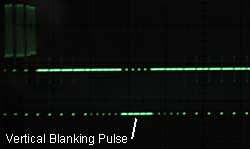 Video systems work on a master/slave basis. If the source and display devices ran their own independent clocks, even extremely accurate ones, there would inevitably be drift -- and every so often there would be a hiccough of some kind. So any video source sends not only the picture, but also timing information. The timing info is actually extremely basic: it's simply the regularly repeated 'retrace' signals. The main one happens every 50th of a second (60th for NTSC) at the end of each full screen scan to display a field and is called the 'Vertical Blanking Pulse'. The subsidiary one happens every 64 microseconds at the end of each scan line, and is called the 'Horizontal Blanking Pulse'.
Video systems work on a master/slave basis. If the source and display devices ran their own independent clocks, even extremely accurate ones, there would inevitably be drift -- and every so often there would be a hiccough of some kind. So any video source sends not only the picture, but also timing information. The timing info is actually extremely basic: it's simply the regularly repeated 'retrace' signals. The main one happens every 50th of a second (60th for NTSC) at the end of each full screen scan to display a field and is called the 'Vertical Blanking Pulse'. The subsidiary one happens every 64 microseconds at the end of each scan line, and is called the 'Horizontal Blanking Pulse'.
So, if your video player is running a bit fast or a bit slow, so long as it's not so far off to cause everything to collapse in a heap, it will drive the display just fine.
Now the time display on your VCR doesn't show elapsed real-time. As Rod suggests, it shows a time made up from counting those vertical blanking pulses. You can confirm this yourself. Take a brand new blank tape, put it into your VCR. Record something for a couple of minutes (broadcast TV will do). Stop the recording. Fast forward for a few seconds from the point at which you stopped. Record something for a couple of minutes. Stop again.
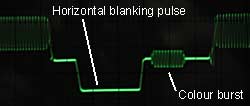 Now, rewind the tape to the beginning and play it back. Watch the tape time display. It will increment in the usual way through the recording. But when it gets to the blank bit (that you fast forwarded over) it will stop incrementing. Then, when it gets to the next recording it will resume incrementing. There are no frames in the blank bit for it to count, which is why it stops.
Now, rewind the tape to the beginning and play it back. Watch the tape time display. It will increment in the usual way through the recording. But when it gets to the blank bit (that you fast forwarded over) it will stop incrementing. Then, when it gets to the next recording it will resume incrementing. There are no frames in the blank bit for it to count, which is why it stops.
The long and short of it is that the tape time display will show you the length of the movie based on its actual number of frames. But if you play back that movie in two different VCRs and time the results, they may be quite different to each other.
A ten second discrepancy isn't that much really. Consider, 10 seconds out in a 90 minute movie is a time drift of less than 0.2%. Not bad for an inexpensive mass-produced consumer device.
(The two pictures show photos of a Cathode Ray Oscilliscope trace of the vertical and horizontal blanking pulses which I just took from a DVD player's composite video output.)
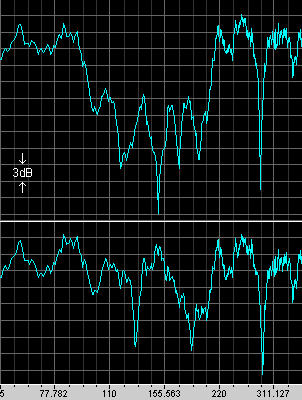 Most subwoofers have a switch on the back that's labelled 'Phase', and has positions of 0 and 180 degrees. What this switch does, electrically, is the second easist thing to understand on a subwoofer's wiring (the easiest is the 'on/off' switch).
Most subwoofers have a switch on the back that's labelled 'Phase', and has positions of 0 and 180 degrees. What this switch does, electrically, is the second easist thing to understand on a subwoofer's wiring (the easiest is the 'on/off' switch).
Put the switch one way, and the two conductors carrying signal from the input are connected to the rest of the electronics in one way. Flick the switch and the two conductors swap position. This means that the waveform is turned upside down (which is what engineers mean when they talk about reversing phase, or switching it 180 degrees).
But what does that mean in terms of the listening experience?
The image on the right is my frequency response graph, measured last night, of a Miller and Kreisel K5 satellite speaker and a K-9 subwoofer working together. This shows the frequency performance from 55 to perhaps 350 hertz. All conditions were identical between these two measurements, except that the Phase switch was in the '+' position in the top one, and the '-' position in the bottom one. M&K recommends that you set the switch to the position which gives the greatest amount of perceived mid and upper bass at the normal listening position.
As you can see from the graph, with the switch in the wrong position for the particular room setup, more than an octave from below 100 hertz to 220 hertz disappears, down in level by an average of about 15 decibels. Nothing subtle about this at all. You can clearly hear the difference.
The reason is that in the area where both the subwoofer and the satellite speakers are producing output, their respective outputs interfere destructively with the switch one way, and constructively the other way. Which way depends upon such things as the locations of the satellites and the sub, the distances between them and the listening position, and the room boundaries. So experiment, otherwise you may not be getting all the bass you've paid for.
Okay, I've done some sorting out. Here is a full list of DVDs I'm giving away. Again, none of these have the printed slicks, although all have properly printed labels on the discs themselves. All are stamped 'Not For Sale'. Anyone who wants any of these will have to make arrangements to get them themselves, or arrange postage or something. Let me know at scdawson [at] hifi-writer.com.
- Buffy, Season 6 (6 discs)
- Firefly, The Complete Series (6 discs)
- I'm With Lucy (Rental Version)
- In America (Rental Version)
- Japanese Story (Rental Version)
- Love's Brother
- Perfect Strangers (Rental version)
- Roswell, Season 1 (6 discs)
- Runaway Jury (Rental Version)
- The Sin Eater (aka 'The Order', Rental version)
- The X Files, Season 6 (6 discs)
- The X Files, Season 7 (6 discs)
- The X Files, Season 9 (7 discs)